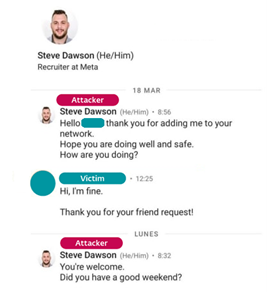- ESET researchers discovered a Lazarus attack against an aerospace company in Spain. Lazarus is a North Korea-linked advanced persistent threat (APT) group.
- Employees of the targeted company were contacted by a fake recruiter via LinkedIn and tricked into opening a malicious executable file presenting itself as a coding challenge or quiz.
- The most notable payload is the LightlessCan backdoor, implementing techniques to hinder detection by real-time security monitoring software and analysis by cybersecurity professionals.
- The final goal of the attack was cyberespionage.
ESET researchers have uncovered a Lazarus attack against an aerospace company in Spain, in which the group deployed several tools, most notably the newly discovered backdoor named LightlessCan by ESET. Operators of the North Korea-linked Lazarus group obtained initial access to the company’s network last year after a successful spearphishing campaign, masquerading as a recruiter for Meta — the company behind Facebook, Instagram, and WhatsApp. The final goal of the attack was cyberespionage.
“The most worrying aspect of the attack is the new type of payload, LightlessCan, a complex and possibly evolving tool that exhibits a high level of sophistication in its design and operation, and represents a significant advancement in malicious capabilities compared to its predecessor, BlindingCan,” explains ESET researcher Peter Kálnai, who made the discovery.
The fake recruiter contacted the victim via LinkedIn Messaging, a feature within the LinkedIn professional social networking platform, and sent two coding challenges supposedly required as part of a hiring process, which the victim downloaded and executed on a company device. ESET Research was able to reconstruct the initial access steps and analyze the tool set used by Lazarus thanks to cooperation with the affected aerospace company. The group targeted multiple company employees.
Lazarus delivered various payloads to the victims’ systems; the most notable is a previously publicly undocumented and sophisticated remote access trojan (RAT) that we named LightlessCan. The trojan mimics the functionalities of a wide range of native Windows commands, usually abused by the attackers enabling discreet execution within the RAT itself instead of noisy console executions. This strategic shift enhances stealth, making detecting and analyzing the attacker’s activities more challenging.
Another mechanism used to minimize exposure is the employment of execution guardrails: Lazarus made sure the payload could be decrypted only on the intended victim’s machine. Execution guardrails are a set of protective protocols and mechanisms implemented to safeguard the integrity and confidentiality of the payload during its deployment and execution, effectively preventing decryption on unintended machines, such as those of security researchers.
LightlessCan has support for up to 68 distinct commands, but in the current version, 1.0, only 43 of those commands are implemented with some functionality. ESET Research has identified four different execution chains, delivering three types of payloads.
The Lazarus group (also known as HIDDEN COBRA) is a cyberespionage group linked to North Korea that has been active since at least 2009. The diversity, number, and eccentricity in implementation of Lazarus campaigns define this group, which performs all three pillars of cybercriminal activities: cyberespionage, cybersabotage, and pursuit of financial gain. Aerospace companies are not an unusual target for North Korea-aligned APT groups. The country has conducted multiple advanced missile tests that violate United Nations Security Council resolutions.
For more technical information about Lazarus, its latest attack, and the LightlessCan backdoor, check out the blog post “Lazarus luring employees with trojanized coding challenges: The case of a Spanish aerospace company” on WeLiveSecurity. ESET Research will present findings about this attack at the Virus Bulletin conference on October 4, 2023. Make sure to follow ESET Research on Twitter (today known as X) for the latest news from ESET Research.
The initial contact by the attacker impersonating a recruiter from Meta

About ESET
For more than 30 years, ESET® has been developing industry-leading IT security software and services to protect businesses, critical infrastructure and consumers worldwide from increasingly sophisticated digital threats. From endpoint and mobile security to endpoint detection and response, as well as encryption and multifactor authentication, ESET’s high-performing, easy-to-use solutions unobtrusively protect and monitor 24/7, updating defenses in real time to keep users safe and businesses running without interruption. Evolving threats require an evolving IT security company that enables the safe use of technology. This is backed by ESET’s R&D centers worldwide, working in support of our shared future. For more information, visit www.eset.com or follow us on LinkedIn, Facebook, and Twitter.